
Original Link: https://www.anandtech.com/show/1023
When one talks about the server and workstation markets and the motherboards used in those markets, most people would immediately think of motherboard manufacturers like Supermicro and Tyan who have historically dominated these areas. However, MSI is now quite a large force in the server and workstation markets. As far as OEM contracts are concerned, at least two of the top four PC OEMs in the world use MSI motherboards in some of their workstation and server models. This type of support is a huge win for MSI, as it validates MSI as a reliable motherboard maker in markets that are known to be very timid when it comes to adopting anything new or innovative.
MSI doesn't just hold server and workstation motherboard wins either; their video cards (NVIDIA-based) are featured in multiple models from lots of different OEMs, including some of the top 4 OEMs in the world. MSI is even gaining market share in the enthusiast and gaming markets with their NVIDIA-powered video cards, despite tough competition from Gainward, Leadtek, and eVGA, in addition to the more motherboard-oriented companies like ABIT, ASUS, Chaintech, and Albatron.
So today we take a look at MSI's latest creation, the MSI 845PE Max2-FIR, yet another 845PE motherboard. This motherboard is, quite simply, one heck of a feature-packed product, and we think you'll like what it has to offer.
|
Motherboard Specifications |
|
|
CPU
Interface
|
Socket-478
|
|
Chipset
|
Intel
82845PE MCH
Intel 82801DB ICH |
|
Bus
Speeds
|
100
- 200MHz (in 1MHz increments)
|
|
Core
Voltages Supported
|
up
to 1.80V (in 0.025V increments)
|
|
I/O
Voltages Supported
|
N/A
|
|
DRAM
Voltages Supported
|
up
to 2.8V in 0.05V increments
|
|
Memory
Slots
|
3
184-pin DDR DIMM Slots
|
|
Expansion
Slots
|
1
AGP 4X Slot
6 PCI Slots |
|
Onboard
RAID
|
Promise
PDC20276
|
|
Onboard
USB 2.0/IEEE-1394
|
USB 2.0
Supported through South Bridge
VIA VT6306 FireWire Controller |
|
Onboard
LAN
|
Intel
RC82540EM Gigabit LAN
|
|
Onboard
Audio
|
C-Media
CMI8738
|
|
Onboard
Serial ATA
|
N/A
|
|
BIOS
Revision
|
A6704IMS
V1.2B24 100802
|
MSI 845PE Max2-FIR Ver. 1: Basic Features
MSI's 845PE Max2-FIR motherboard comes with a very interesting and unique combination of features that no other motherboard manufacturer has been able to provide before.
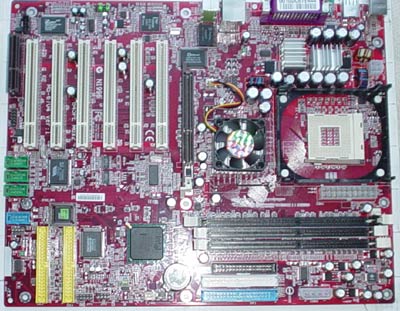
The most unique feature present on the MSI 845PE Max2-FIR is the LAN chip. MSI chooses Intel's RC82540EM Gigabit LAN chip, supporting up to 1000Mbit/s bandwidth. It's interesting to note that this is the first motherboard that we've seen that uses this particular Intel Gigabit LAN chip. Unfortunately most users won't be able to take advantage of this technology for a while, but at least MSI is thinking ahead.
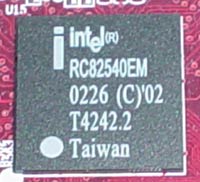 |
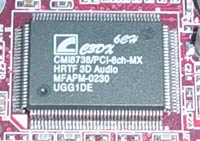 |
MSI chooses C-Media's popular CMI8738 audio chip for onboard sound. It's more common to see Realtek sound chips than C-Media chips on motherboards these days.
The I/O configuration of the MSI 845PE Max2-FIR isn't anything special, as it comes with some plain features like two PS/2 ports, one serial port, one parallel port, four rear USB 2.0 ports, a LAN port, and Mic In, Line In, and Line Out, which are driven by the onboard sound. It's good to know that motherboard makers are finally starting to come around and include multiple rear USB 2.0 and LAN ports as standard. Soon enough rear FireWire will be standard and it won't be long before we start seeing RAID and Serial ATA integrated into Intel, SiS, and VIA's South Bridges.
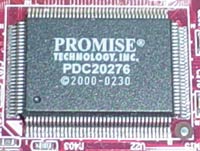 MSI
goes ahead and adds a very common RAID chip, the Promise PDC20276 controller.
This controller is accessed by two yellow onboard IDE connectors that support
two channels each (a max of four IDE devices total) as well as RAID 0 (striping)
and RAID 1 (mirroring). MSI doesn't add any Serial ATA here, and this is pretty
understandable as onboard Serial ATA chips have to use the limited bandwidth
of the PCI bus. Ideally, motherboard manufacturers would just wait for chipset
manufactures to release chipsets with native support for Serial ATA, which would
allow Serial ATA devices to eat up bandwidth available directly through the
chipset's own I/O links, which offer much more bandwidth (anywhere from 200
to 1000MB/s more bandwidth with today's chipsets, even more in the future).
Taking into account the Primary and Secondary IDE connectors, the MSI 845PE
Max2-FIR is capable of supporting up to eight IDE devices total. This is a good
feature to have if you want to connect more than "just" a DVD drive,
CD-RW drive, or two hard drives (in RAID perhaps). This setup by itself is pretty
high-end, as most people who wouldn't want to configure any of their drives
in a master/slave setup will be happy with MSI's IDE and RAID support.
MSI
goes ahead and adds a very common RAID chip, the Promise PDC20276 controller.
This controller is accessed by two yellow onboard IDE connectors that support
two channels each (a max of four IDE devices total) as well as RAID 0 (striping)
and RAID 1 (mirroring). MSI doesn't add any Serial ATA here, and this is pretty
understandable as onboard Serial ATA chips have to use the limited bandwidth
of the PCI bus. Ideally, motherboard manufacturers would just wait for chipset
manufactures to release chipsets with native support for Serial ATA, which would
allow Serial ATA devices to eat up bandwidth available directly through the
chipset's own I/O links, which offer much more bandwidth (anywhere from 200
to 1000MB/s more bandwidth with today's chipsets, even more in the future).
Taking into account the Primary and Secondary IDE connectors, the MSI 845PE
Max2-FIR is capable of supporting up to eight IDE devices total. This is a good
feature to have if you want to connect more than "just" a DVD drive,
CD-RW drive, or two hard drives (in RAID perhaps). This setup by itself is pretty
high-end, as most people who wouldn't want to configure any of their drives
in a master/slave setup will be happy with MSI's IDE and RAID support.
Just like all 845PE motherboards, the MSI 845PE Max2-FIR provides support for USB 2.0. This is made possible through Intel's ICH4 South Bridge, which offers support for as much as six USB 2.0 ports. Very few 845PE motherboards we've tested utilize an additional onboard USB 2.0 chip for more on-board ports, so there's nothing new here.
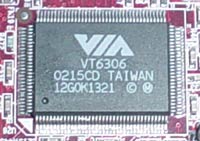
Another technology we like to see included is FireWire support. There are no rear FireWire ports, but MSI does add in three, well-positioned FireWire headers located at the bottom of the motherboard and powered by VIA's VT6306 FireWire controller.
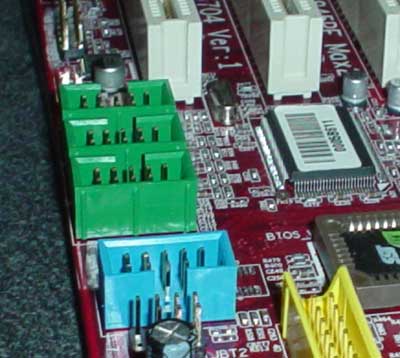
MSI includes a two-port FireWire bracket for your use.
MSI 845PE Max2-FIR: Board Layout
The MSI 845PE Max2-FIR had a fair amount of layout issues that we felt were important to point out.
The positioning of the ATX (20-pin) connector isn't too ideal. The ATX connector is located on the preferable side of the motherboard, but it's closer to the center of the right-hand side of the motherboard, which isn't so preferable. In fact, the ATX connector is so close to the center of the upper part of the motherboard that it touches the CPU clamps.
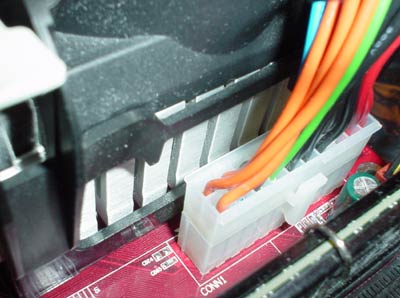
This is another layout decision that we're being critical of, because it becomes nearly impossible to uninstall the HSF without having to first unhook the ATX connector.
The CPU fan header is yet another item that isn't placed ideally. It's located right next to the ATX connector, which isn't good, and even a tiny capacitor makes its way over next to the CPU fan header. In fact, this little capacitor is so close to the CPU fan header that we can't even unhook the CPU fan line without having to tug on the wires themselves.
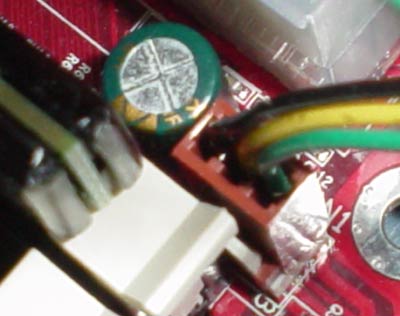
We have no idea why MSI didn't place this tiny capacitor somewhere else, and why they placed the ATX connector so close to the HSF.
The ATX12V connector isn't located too well either, although it wasn't as severe as the other issues we mentioned. The ATX12V connector is located on the left-hand side of the motherboard, at the very top of the board, somewhat close to the CPU socket. This isn't the best location to place the ATX12V connector because the ATX12V line is directly in your path of uninstalling the HSF. If MSI had kept the ATX12V connector at the top of the motherboard but on the opposite end, it would have been positioned perfectly.
Luckily enough, MSI places the Primary/Secondary IDE connectors above our video card. Placing these IDE connectors below our video card would have made it more difficult for the IDE cables to reach to the uppermost bays of a large-sized ATX case, and would have also gotten somewhat tangled up with our video card. The RAID connectors are located below our video card, which is actually a good thing; since the hard drive bays are usually located towards the bottom (and sometimes middle) of a conventional computer case, your IDE cables (running from your RAIDed hard drives) won't have any problems reaching its destination whatsoever.
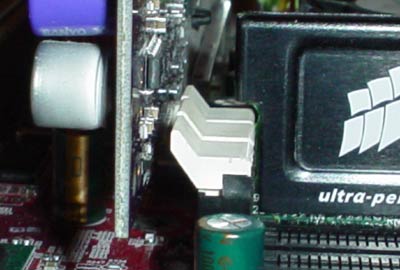
There are far too many motherboard manufacturers that place their DIMM connectors close to where a video card would be. MSI, unfortunately, is one of them. The 845PE Max2-FIR's DIMM aren't located far enough away from our GeForce4 Ti4600 unfortunately. We see in the above picture that the connectors are simply much too close to the video card for us to be able to uninstall our memory without forcing us to first uninstall the video card. This is quite the annoyance, and somewhat common with 845PE motherboards.
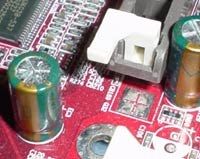
MSI also places yet another tiny capacitor in the way, this time right next to the AGP lever. This makes it difficult to uninstall a video card without touching the capacitor and bending it a bit.
We were pretty pleased with the rest of the MSI 845PE Max2-FIR's layout though. Moving towards the bottom of the motherboard we see three green FireWire headers sitting to the right of the last PCI slot. We have always preached about this type of positioning, as FireWire bracket wires won't get tangled up too badly with other PCI cards that you may install. We also see that the USB 2.0 header is located well, right next to the FireWire headers at the bottom of the motherboard.
MSI 845PE Max2-FIR: BIOS and Overclocking
A fairly common BIOS among most modern-day motherboards today, the MSI 845PE
Max2-FIR uses the AMI BIOS.
There's a good amount of information embedded in the PC Health section of this AMI BIOS.

You'll find readings on CPU temperature, system temperature, fan speeds, Vcore, PSU readings (all rails), and even Battery voltage. This amount of info is about the norm as far as PC Health sections and Hardware Monitors are concerned. One odd thing we noticed with the PC Health readings was that it consistently reported our 2.26GHz CPU as running about 47-50C. This was odd because nearly every Pentium 4 motherboard we've used have reported a CPU temperature no higher than 43C in the BIOS, with as low as 33C being reported by a select few motherboards. This says something about the accuracy of reading temperatures from the Pentium 4's on-die thermal diode.
There were not a whole lot of options available in the Advanced Chipset Features section of the BIOS, which is normal for most MSI Pentium 4 motherboards.
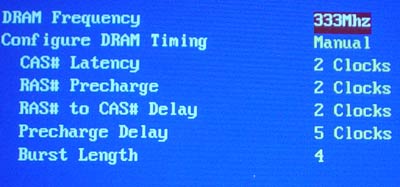
You're only able to adjust CAS Latency, Precharge to Active, Active to Precharge, Active to CMD, and Burst Length (Burst Length isn't too important though). We would have loved to have seen some Bank Interleave, Command Rate, or DRAM timing mode adjustments. However, it seems the vast majority of motherboard makers simply aren't including these three additional options for their 845PE motherboards for one reason or another.
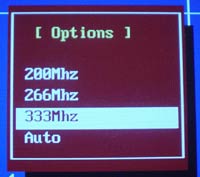
What's most disappointing about the BIOS tweaking that comes with this board is the lack of any adjustable memory dividers in any shape or form. You're limited to just DDR266 or DDR333 despite how high you may overclock your FSB. We would have liked to have seen if this board could reach 400MHz memory clock, but that doesn't seem like it's going to happen in any future BIOS revision. There were no onboard jumpers or switches that could have changed the BIOS settings with this motherboard either.
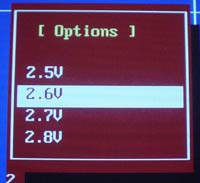
There were some pretty decent voltage adjustments in this particular BIOS. VDIMM options went as high as 2.8V in 0.1V increments. This should be plenty for most memory overclockers, even despite the fact that overvolting memory doesn't yield too much better of a memory overclock to begin with. VAGP was very good too, being adjustable as high as 1.8V. This won't disappoint too many video card overclockers, but like VDIMM and memory, it's not all that necessary to raise VAGP to get a good video card overclock.
Vcore is adjustable as high as 1.80V in .025V increments, though in actuality you will only get as high as 1.76V-1.78V max, as default Vcore (as read through the PC Health section) fluctuates between 1.45-1.48V. However, this isn't too much of a limitation, as running over 1.7V using regular retail air cooling for a long time isn't advisable anyway.
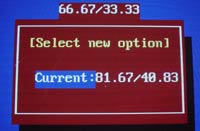
Just like every 845PE-based motherboard we've tested in the past, the MSI 845PE Max2-FIR comes with an independent AGP/PCI lock running at 66.67MHz/33.33MHz. This feature has played a key part in allowing numerous 845 users to overclock their FSB to very high speeds. As should be common knowledge by now, running your AGP or PCI cards too far out of spec can damage those parts.
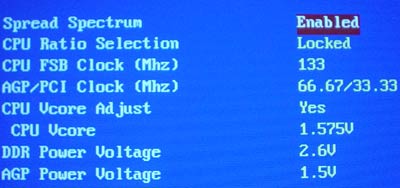
MSI's 845PE wasn't disappointing at all as far as FSB overclocking was concerned. The following table lists the components we used for overclocking the FSB using the MSI 845PE Max2-FIR motherboard:
|
Front Side Bus Overclocking Testbed |
|
|
Processor:
|
Pentium
4 2.26GHz
|
|
CPU
Vcore:
|
1.5V
(actual)
|
|
Cooling:
|
Intel
Retail HSF & Thermal Pad
|
|
Power
Supply:
|
Enermax
300W
|
With this very conservative overclocking setup we were able to go "only" as high as 160MHz FSB, or just over 2.70GHz core clock. Again, this type of overclock is not out of the ordinary for 845 motherboards, especially 845PE motherboards. As we said in our previous 845PE review (AOpen AX4PE Max) expect your overclocks to average between 160MHz-166MHz using our FSB Overclocking Testbed. Of course, that would assume you get CPU that overclocks at least as good as ours does.
Just like AOpen's AX4PE Max motherboard, the MSI 845PE Max2-FIR lacks memory flexibility (or overclocking) options in the BIOS. All in all, the Max2-FIR ends up being only a mediocre DDR333 performer…
MSI 845PE Max2-FIR: Stress Testing
The MSI 845PE Max2-FIR did not have a lot of stress testing potential, very similar to the AOpen AX4PE Max. As a result of these facts, we weren't able to run as many stress tests as we usually do, although we added more brands of memory to spice up the possible problems that might arise with stress testing. We still managed to test this board in several different areas and configurations, including:
1. Chipset and motherboard stress testing was conducted by running the FSB at 160MHz.
2. Memory stress testing was conducted by running RAM at 333MHz with one bank filled as well as as many as was possible from that point on with the most aggressive timings available.
The MSI 845PE Max2-FIR performed like a champ in our numerous FSB stress tests running at 160MHz FSB. The Max2-FIR was able to run exactly one full day (24hrs) of Prime95 torture tests under these conditions. Ideally we would have to run months of Prime95 torture tests in addition to general applications and benchmarks to better guage the stability and reliability of the MSI 845PE Max2-FIR (we would have to run these tests on dozens of these boards to ensure our board isn't an exception to the rule). Unfortunately, that type of scenario is obviously quite unrealistic and beyond even our resources. So, in addition to the successful Prime95 stress tests, we reran our entire benchmark suite several times over at 160MHz FSB in addition to general application usage (such as data compression, Word, IE, Outlook, etc.). All of our stress tests proved successful at 160MHz FSB.
This first scenario is very basic, all 845PE motherboards should (and have so far) be able to run memory at 333MHz with just one DIMM installed, preferably at aggressive memory timings. Here were our results in this conservative DDR333 situation with one Corsair DIMM running at 333MHz with the most aggressive timings possible:
|
Stable
DDR333 Timings |
|
|
Clock
Speed:
|
166MHz
|
|
Timing
Mode:
|
N/A
|
|
CAS
Latency:
|
2
|
|
Bank
Interleave:
|
N/A
|
|
Precharge
to Active:
|
2T
|
|
Active
to Precharge:
|
5T
|
|
Active
to CMD:
|
2T
|
|
Command
Rate:
|
N/A
|
These are great timings, and exactly what you should expect with this type of memory and chipset. It should be noted that high quality memory is a must to achieve these timings, especially if you're going to be running more than one DIMM at a time.
After completing a very simple DDR333 run with one DIMM installed, we moved on to the most strenuous situation possible at stock memory speeds with this particular motherboard, which was 2/3 banks filled with memory running at 333MHz. We were able to achieve the following DRAM settings:
|
Stable
DDR333 Timings |
|
|
Clock
Speed:
|
166MHz
|
|
Timing
Mode:
|
N/A
|
|
CAS
Latency:
|
2
|
|
Bank
Interleave:
|
N/A
|
|
Precharge
to Active:
|
2T
|
|
Active
to Precharge:
|
5T
|
|
Active
to CMD:
|
2T
|
|
Command
Rate:
|
N/A
|
These are without a doubt very good timings and the majority of users will be happy with this combination of memory performance at 333MHz. However, we're still disappointed that we couldn't run three sticks of memory at 333MHz, as there are quite a few users out there that like to use as much memory as possible in their systems. MSI needs to work on this aspect of the Max2-FIR, especially since we've seen more than a couple of 845PE boards run three DIMMs at 333MHz with similar DRAM timings.
To ensure these timings were stable we ran our usual array of stress tests. We ran Prime95 torture tests for hours at a time at the timings listed in the charts above. In fact, the MSI 845PE Max2-FIR was able to withstand an impressive 48 hours of Prime95 torture tests. During the time this board was being stressed, we also performed general tasks like running Word, Outlook, IE, and some data compression here and there. Our Super Pi tests also proved successful, as the most strenuous runs didn't faze the Max2-FIR.
Due to the constrained memory options and adjustments available in the Max2-FIR's BIOS, we were forced to run additional memory tests on this motherboard. These memory tests are exactly the same ones that were run in our previous 845PE review, which featured the AOpen AX4PE Max. So as before, we decided to install multiple types of memory from different manufacturers. Samsung, Kingston, Twinmos, Mushkin, and Corsair memory were all tested at the frequency of 333MHz on the MSI 845PE Max2-FIR. Due to the massive amount of different memory modules used, we were only able to run Prime95 for a handful of hours at a time. Still, we're fairly happy to report that after hours of testing, all memory modules except Mushkin's passed our Prime95 torture tests. For some odd reason, there seemed to be a problem with running two Mushkin modules (normally rated at CL2.5 DDR400) at 333MHz. We couldn't seem to run both Mushkin modules at CAS 2-2-2-5 timings, even though this was continuously repeatable with four different brands of DDR333 or better memory. Perhaps this issue is only regulated to this particular MSI motherboard, as we haven't encountered a problem with Mushkin memory with any other 845PE motherboard.
MSI 845PE Max2-FIR: Tech Support and RMA
For your reference, we will repost our tech support evaluation procedure here:
The way our Tech Support evaluation works is first we anonymously email the manufacturer's tech support address(es), obviously not using our AnandTech mail server to avoid any sort of preferential treatment. Our emails (we can and will send more than one just to make sure we're not getting the staff on an "off" day) all contain fixable problems that we've had with our motherboard. We then give the manufacturer up to 72 hours to respond over business days and will report not only whether they even responded within the time allotted but also if they were successful in fixing our problems. If we do eventually receive a response after the review is published, we will go back and amend the review with the total time it took for the manufacturer to respond to our requests.
The idea here is to encourage manufacturers to improve their technical support as well as provide new criteria to base your motherboard purchasing decisions upon; with motherboards looking more and more alike every day, we have to help separate the boys from the men in as many ways as possible. As usual, we're interested in your feedback on this and other parts of our reviews so please do email us with your comments.
MSI's RMA process is actually non-existent for end users. Their policy is pretty straight forward, and is as follows:
|
As you can clearly see, end users must contact the vendor from which they purchased their MSI motherboard from (like Newegg or Mwave for example) if they want an RMA. MSI does not directly take RMA's according to their web site. The remaining info above only applies to resellers.
However, MSI's tech support was significantly better. We received a response from their tech support staff in just under 64 hours. MSI was able to correctly diagnose our "problem", which is good, and in general we were pleased that a large manufacturer like MSI was able to provide this type of support, as other large motherboard manufacturer's tech support have been much less responsive.
MSI offers a very clear and informative amount of technical support in addition to their good tech support response time. If you go to MSI's U.S. page on technical support you'll find contact information for the Sales, Marketing, and Technical Support departments as well as three different Regional offices you can contact during the week if you have any questions about MSI products in general. There are even "Direction and Map" links that offer a way for the user to visit MSI's Regional offices.
MSI is also able to provide tech support and information to many different countries, continents and languages. Some of these countries and continents include Australia, Brazil, China, Czech, France, Germany, Hong Kong, Japan, Netherlands, Russia, Taiwan, and the USA among others.
MSI's RMA policy is clearly disappointing, especially compared to the smaller motherboard makers. However, this is the norm for a large motherboard maker like MSI (for example, ASUS and Gigabyte's tech support and RMA weren't that great). However, MSI's technical support response time was fairly quick, and the general contact, sales, and marketing information that's provided are positive aspects of MSI's customer service.
The Test
|
Performance Test Configuration |
||
| Processor(s): |
Intel
Pentium 4 2.26GHz
|
|
| RAM: |
256MB Samsung DDR333 CAS2.5 Modules
256MB Kingston DDR333 CAS2.5 Modules 256MB Twinmos DDR400 CAS2.5 Modules 256MB Mushkin DDR400 CAS2.5 Modules 256MB Corsair DDR400 CAS2.0 Modules |
|
| Hard Drive(s): |
Western Digital 120GB 7200 RPM
Special Edition (8MB Buffer)
|
|
| Bus Master Drivers: |
Intel Application Accelerator
v2.2.2
SiS Chipset Patches |
|
| Video Card(s): |
ASUS
V8460 Ultra NVIDIA GeForce4 Ti 4600
|
|
| Video Drivers: |
NVIDIA
Detonator 30.82
|
|
| Operation System(s): |
Windows
XP Professional
|
|
| Motherboards: |
Albatron PX845PEV Pro (845PE)
ASUS P4B533-E (845E) AOpen AX4PE Max (845PE) ASUS P4B533-V (845G) ASUS P4PE (845PE) ASUS P4GE-V (845GE) ASUS P4T533-C (850E) Epox 4PEA+ (845PE) Gigabyte 8PE667 Ultra (845PE) Gigabyte 8SG667 (SiS 648) Intel D845PEBT2 (845PE) MSI 845PE Max2-FIR (845PE) |
|
All performance tests were run using a 256MB Corsair XMS DDR400 module set to CAS 2-2-2-5 timings. Any other performance-enhancing timings (like Command Rate or Bank Interleave) were enabled in motherboards that contained such timings.
The AnandTech Motherboard Testbed was Sponsored by Newegg. You can buy the components we used to test at www.newegg.com.
Content Creation & General Usage Performance
For our Content Creation & General Usage performance we continue to use SYSMark 2002. The applications benchmarked include:
· Internet Content Generation: Adobe Photoshop® 6.01, Adobe Premiere® 6.0, Microsoft Windows Media Encoder 7.1, Macromedia Dreamweaver 4, and Macromedia Flash 5
· Office Productivity: Microsoft Word 2002, Microsoft Excel 2002, Microsoft PowerPoint 2002, Microsoft Outlook 2002, Microsoft Access 2002, Netscape Communicator® 6.0, Dragon NaturallySpeaking Preferred v.5, WinZip 8.0, and McAfee VirusScan 5.13.
For more information on the methodology and exactly what SYSMark does to generate these performance scores check out BAPCo's SYSMark 2002 Whitepaper.
|
|
Gaming Performance
|
|
Gaming Performance (continued...)
|
|
High End Workstation Performance - SPEC Viewperf 7.0
The latest version of SPEC Viewperf proves to be an excellent stress test for memory bandwidth and overall platform performance as you're about to see. The benchmarks included version 7 of the benchmark suite are:
3ds max (3dsmax-01)
Unigraphics (ugs-01)
Pro/Engineer (proe-01)
DesignReview (drv-08)
Data Explorer (dx-07)
Lightscape (light-05)
For more information on the tests run visit SPEC's page on the new Viewperf benchmark.
|
|
|
High-End Workstation Performance (continued...)
|
|
|
Final Words
There are a lot of positive things we can say about MSI's latest Pentium 4 motherboard, the 845PE Max2-FIR. Let's list exactly what this board offers to different types of users:
1. For those users that are on a tight budget and simply need a fast and cheap motherboard, the MSI 845PE Max2-FIR clearly isn't the right choice. The sheer amount of onboard features adds enough cost that it places this motherboard in the following two categories.
2. For those users that are simply interested in a feature-filled, fast, and reasonably priced motherboard, the MSI 845PE Max2-FIR fits the bill indeed. The combination of RAID, FireWire and Gigabit among other tasty features should please the vast majority of users looking for an all-in-one motherboard.
3. For those users that desire a flexible and overclockable motherboard no matter the price, the MSI 845PE Max2-FIR is again able to fulfill this niche. MSI's 845PE motherboard was clearly able to sustain nearly the average overclock that we've seen with 845PE motherboards, not to mention the fact that we would have been able to go higher if we had decided to adjust all the abundant voltages available in the Award BIOS.
It's quite clear that MSI has done a great job in balancing a combination of onboard features, tweakability, and perhaps most importantly price with the 845PE Max2-FIR. Currently, you can purchase the MSI 845PE Max2-FIR for between $150-160 online. This price is competitive with other feature-filled 845PE solutions out on the market currently.
Still, we can't help but mention two important factors to take into consideration if you're pondering whether or not to purchase this motherboard. The first factor you must consider is the competition. If you truly wanted a budget 845PE motherboard, then you'd more than likely opt for Albatron's PX845PEV Pro. If you truly desired a fully loaded and integrated all-in-one solution, ASUS's P4PE motherboard might be the best choice. And if you were serious about getting a truly tweakable and overclockable motherboard, the Epox 4PEA+ or Albatron PX845PEV Pro II might be the best bet. All in all it's a tough 845PE market out there, but MSI has at least shown that they can hang with the best of them with the 845PE Max2-FIR.







